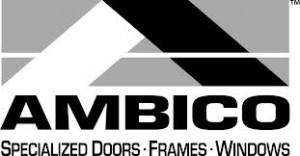A
Active Door (in a pair of doors)-The leaf that opens first and the one to which the lock is applied.
AHC-Indicates that the individual so identified is a qualified Architectural Hardware Consultant and member of the Door and Hardware Institute.
Anti-Friction Bearing-Any bearing having the capability of effectively reducing friction.
Anti-Friction Latch Bolt-A latch bolt designed to reduce friction when the bolt starts to engage the lock strike.
Architectural Hardware-Term applied to all hardware used in building construction but particularly that used on or in connection with doors, windows, cabinets and other movable members.
Armored Front-A lock that consists of two plates: the under plate is fastened to the case and is unfinished; the finish plate is fastened to the under plate and when in place covers the cylinder set screws, thus protecting them from tampering. Used on mortise locks.
Armor Plate-A plate similar to a kick plate but covering the door to a greater height, usually 40? (1040mm) or more from the bottom.
Astragal-A molding or strip whose purpose is to cover or close the gap between the edges of a pair of doors. Some types overlap, others meet at the center line of the gap. (See Coordinator)
Auxiliary Dead Latch -A supplementary latch that automatically deadlocks the main latch bolt when the door is closed. (Also called Deadlocking Latch Bolt)
B
Back Check-Optional feature in hydraulic door closers slowing the opening swing of the door somewhere between 60 degrees and 85degrees of opening. Designed to protect an object behind the door. Not intended to act as an overhead stop.
Backset (of a lock)-The horizontal distance from the face of the lock to the center line of knob hub keyhole or cylinder. (Measured from the high side of a beveled door.)
Backset (of a hinge)-The distance from the edge of the door to the hinge.
Ball-Bearing Hinge -A hinge equipped with ball bearings between the hinge knuckles to reduce friction. (See Anti-Friction Bearing)
Bevel (of a door)-The angle of the lock edge in relation to the face of the lock stile. Standard bevel is 1/8? in 2? (3.2mm in 50.8mm). If otherwise detailed, it must be so noted in ordering locks.
Bevel (of a lock)-A term used to indicate the direction in which the latch bolt is inclined: regular bevel for doors opening in, reverse bevel for doors opening out.
Bevel (of a lock front)-The angle of a lock front when not at right angle to the lock case, allowing the front to be applied flush with the edge of a beveled door.
Bit (of a key)-The projecting blade, cut in a manner that actuates the tumblers and permits the lock bolts to be operated.
Bored Lock (or Latch)-Lock or latch whose parts are intended for installation in holes bored in a door.
Box Strike-A strike that also provides a complete housing to protect the bolt openings.
Builders’ Hardware-See Architectural Hardware
Butt (Hinge)-A type of hinge designed for mortising into the edge of the door and into the rabbet of a door frame.
C
Cam (of a cylinder)-A rotating piece attached to the end of the cylinder plug to engage the locking mechanism.
Cane Bolt-A heavy cane-shaped bolt with the top bent at right angles; used on the bottom of doors.
Case (of a lock)-The box containing the lock mechanism.
Casement Hinge-A hinge to swing a casement window. The term is often used to describe a hinge designed to throw the sash out far enough to permit cleaning the outside of the glass from the inside of the room on an outward-swinging casement.
CDC-Indicates that the individual so identified is a Certified Door Consultant and member of the Door and Hardware Institute.
Chain Bolt-A spring bolt actuated by a chain attached to the spring bolt for application at the top of the door.



